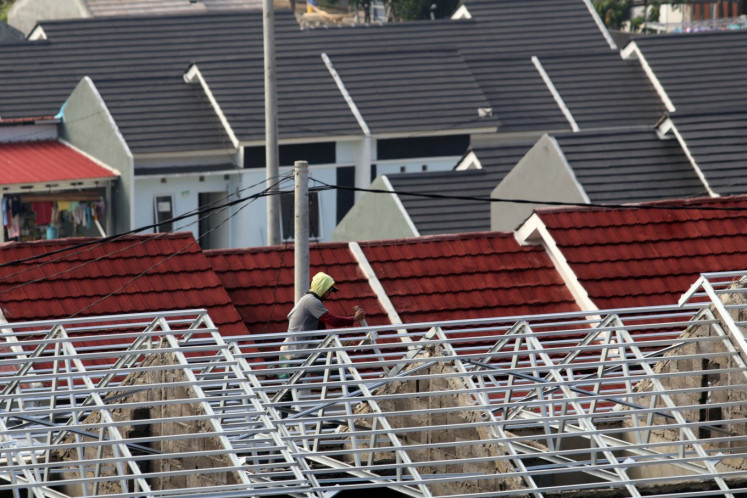Popular Reads
Top Results
Can't find what you're looking for?
View all search resultsPopular Reads
Top Results
Can't find what you're looking for?
View all search resultsNavigating to a new normal of transport activity after COVID-19
Considering that COVID-19 will never go away, transport planners across the world, especially in Indonesia, need to re-plan the transport infrastructure and operation activities. Digitization will be the key, where less human contact is required for transport activities.
Change text size
Gift Premium Articles
to Anyone
"Geez, what the hell is going on in their minds?!" said a lady I follow on social media. "You know what, I just need to fake that health certificate to get into that airport queue!" another man commented.
These are the kinds of responses from Indonesia citizens upon seeing pictures of the crowded Terminal 2E of Soekarno-Hatta International Airport recently, when the government relaxed restrictions on transportation services for certain individuals.
The policy has resulted in quiet business trips happening amid this health crisis. Some citizens blame the government for the bizarre regulation. Others concluded that the stubbornness of the passengers caused it. Others still mentioned that this was the result of a combination of unclear rules and passengers’ ego.
It's clear that for most of us who are complying with the government’s stay-at-home regulation and avoiding the Idul Fitri mudik (exodus) to help break the chain of COVID-19 transmission, we are being fooled by this combination of behaviors.
But most of us do not realize that COVID-19 will navigate our transport activities into a new normal. Dr. Mike Ryan, an executive director of the WHO's health emergency program, has said that this virus just might become another endemic virus in our communities like HIV, and this virus may never go away. This statement will affect all types of new normal in our daily activities, especially in transportation.
If we compare all transportation modes, whether by air, sea or road, the clear theory is that passenger traffic will be affected much by this virus. Though the worst affected by the pandemic is air transport.
Read also: Lion Air Group temporarily suspends domestic flights amid confusion
The International Civil Aviation Organization (ICAO) projects that there will be a 48 percent decline in air transport passengers globally. In Indonesia, during March 2020, the plunge reached 34 percent.
In maritime transport, cargo traffic is not so severely impacted as passenger traffic via cruises, as a result of less human contact required compared to air transport. In Tanjung Priok, Indonesia's biggest port, there was a 5 percent decrease in container traffic during February and March 2020. Globally, seaport traffic has fallen 20 percent.
Considering that COVID-19 will never go away, transport planners across the world, especially in Indonesia, need to re-plan the transport infrastructure and operation activities. Digitization will be the key, where less human contact is required for transport activities.
In airports, we expect more usage of e-boarding passes, e-luggage tags, more physical distance between passengers in waiting rooms, contactless dine-in, contactless security checking and border control, etc.
Ports should remain open to keep supply chains intact and to allow cargo trade to happen. More measures need to be taken in logistics processes in warehouses, container yards and stevedoring. Several steps are advised by the United Nations Conference on Trade and Development (UNCTAD): digital documentation to limit human contact to a minimum, provision of enough protective equipment for port workers, and identifying decontamination areas in port buildings.
Driverless buses will be a sensible option to avoid human contact between driver and passengers.
On the side of transportation infrastructure planning, there will be a slump in demand in the coming months and years if vaccines remain unavailable. With the 2-meter physical distancing requirement, airport terminals require more space for passengers to wait, board and dine in.
For urban transport, long queues will occur as people wait to board buses, commuter line trains and the MRT. At seaports, a larger buffer area is needed to store the cargo used for decontamination or inspection.
Research by The Guardian shows that if people apply physical distancing of 2 meters while taking the regular commuter line in London, the queue from some commuter stations will stretch back two stops. In Indonesia, there is quite a challenge for both the government and citizens to follow the 2 meter distancing rule. As we can see, there are still crowds in some MRT and commuter line stations.
All in all, the new normal of transport activity will change the entire transport infrastructure plan that was initiated 20 years ago. The plan needs revising.
It will take more efforts to update the demand forecast and translate the demand into the new capital and operational expenditure. But it is what it is to keep our economy striving.









